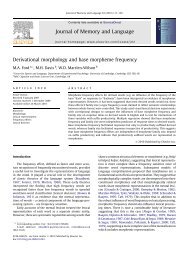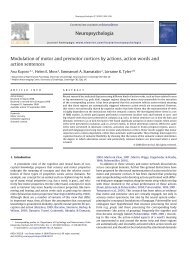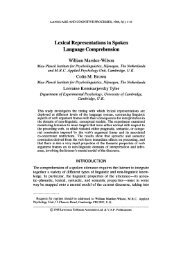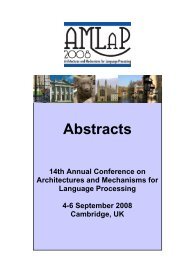Towards a psychological basis for a theory of anaphora - Centre for ...
Towards a psychological basis for a theory of anaphora - Centre for ...
Towards a psychological basis for a theory of anaphora - Centre for ...
You also want an ePaper? Increase the reach of your titles
YUMPU automatically turns print PDFs into web optimized ePapers that Google loves.
we were making are illustrated by the following set <strong>of</strong><br />
sentences:<br />
la) The church was broken into last night. Some<br />
thieves stole most <strong>of</strong> the lead <strong>of</strong>f the ro<strong>of</strong>.<br />
lb) The power was located into great water.<br />
puzzle some in the lead <strong>of</strong>f the text.<br />
lc) Into was power water the great located.<br />
no puzzle buns in lead text the <strong>of</strong>f.<br />
No buns<br />
Some the<br />
The major variable hers is the distinction<br />
between<br />
prose types. In (la) - Normal Prose - not only is a<br />
syntactic analysis <strong>of</strong> tha string possible, but also what<br />
we will call an interpretative analysis. By this we<br />
mean the interpretation <strong>of</strong> an utterance in its discourse<br />
context, and in terms <strong>of</strong> the listener's general<br />
knowledge <strong>of</strong> the world - in short, what is generally<br />
thought <strong>of</strong> as "understanding" [l]. In (lb) - Anomalous<br />
Prose - only a <strong>for</strong>m <strong>of</strong> syntactic structuring <strong>of</strong> th2<br />
input is possible, while in (lc) - Scrambled Prose - the<br />
subject haars an unstructured list <strong>of</strong> words.<br />
The second important variable was the position <strong>of</strong><br />
th2 target-word in the test-sequ~nce. In the examples<br />
given above, the target-word ("lead") appears in seventh<br />
position in the second sentence. Over the 81<br />
test-sequences, with their associated 81 target-words,<br />
the location <strong>of</strong> the target-word varied from the second<br />
to the tenth word-position in tha second test-sentence.<br />
The purpose <strong>of</strong> this was as follows. We assume that the<br />
availability <strong>of</strong> an interpretative and syntactic analysis<br />
in Normal Prosa can facilitate the recognition <strong>of</strong> the<br />
target word. The word-position variable enables us to<br />
track the availability <strong>of</strong> these sources <strong>of</strong> contextual<br />
constraint as they develop 3cross the sentence. As such<br />
constraints become available - that is, as the<br />
appropriate <strong>for</strong>m <strong>of</strong> representation <strong>of</strong> the input sequence<br />
is developed by the listener - then we should begin to<br />
find differences in per<strong>for</strong>mance in Normal Prose as<br />
opposed to Anomalous Prose, and in Anomalous Prose as<br />
opposed to Scrambled Prose.<br />
I'he third main variable was the presence or absence<br />
<strong>of</strong> a lead-in sentence - that is, <strong>of</strong> the first sentence<br />
in each test-sequence. First, we will examine thz<br />
results <strong>for</strong> the case where the lead-in sentrenca is<br />
present. The tasks we used were a vari&ty <strong>of</strong><br />
word-monitoring tasks, where tha subjects were told in<br />
advance <strong>of</strong> each sequence what the target was, under<br />
various <strong>for</strong>ms <strong>of</strong> description <strong>of</strong> the input. The subjects<br />
simply pressed a response-key as soon as the target-ward<br />
in question had been identified (<strong>for</strong> further details,<br />
see Marslen-Wilson & Tyler, 1980).






